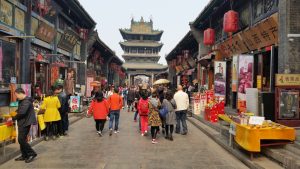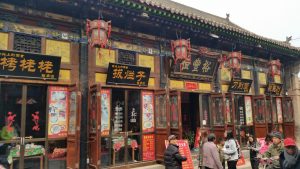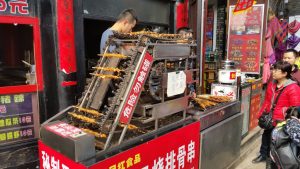After a leisurely second day in Datong, we caught our second night train. We had enjoyed the relative comfort of our hotel until the early afternoon, then retreated to the most remarkable coffee house I’ve ever seen.
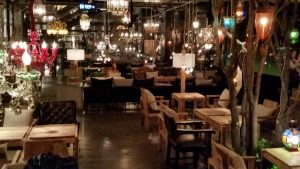
Called Maan’s, it is a warehouse-sized building, with 4-5 stories, all beautifully appointed with comfortable stuffed chairs and couches, and thousands of chandeliers. Featuring espresso drinks, waffles (yeah really), and toast (hot toasted sandwiches), it was a unique experience. Any time someone enters the entire staff shouts a greeting (we supposed) in unison. It was certainly a nice place to while away some time and catch up some writing.
Our night train dropped us off at 6AM in a quiet, sleeping Pingyao. Pingyao, Shanxi is China’s best preserved ancient walled town. Lonely Planet calls it a wander through ancient China. We found a taxi driver who took us to a small café. It was closed and dark. But he let us in and called the owner, who showed up in about 10 minutes and proceeded to cheerfully provide us hot coffee and hot breakfast. Then she offered to keep our bags while we explored the town. Where else in the world would something like that happen? Pretty cool. As we were ready for some sightseeing we departed for nearby Zhangbi. Zhangbi Underground Castle, as the guidebooks and tourist brochures call it, is really an underground fort. 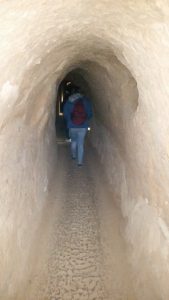 It is a 1400 year old network of defense tunnels, not unlike Cu Chi in Vietnam. The tunnel network stretches for over 10 kilometers and is the oldest and longest such fortification in China. It was built during the Sui dynasty for defense against Tang invaders. Today only about 5000 feet of tunnels are reinforced and accessible to visitors. But one descends as deep as 80-85 feet underground to view storage rooms, guardhouses, bedrooms, ambush niches, escape routes, and air holes. Its pretty interesting. After surveying the underground network, you emerge at the far end of the tiny village of Zhangbi Cun. The stroll back through the now deserted village is almost as interesting with tiny temples, stages, and tile-roofed houses. We had hired a guide - I think we could have managed the tunnels but I know I would have gotten confused trying to navigate the village.
It is a 1400 year old network of defense tunnels, not unlike Cu Chi in Vietnam. The tunnel network stretches for over 10 kilometers and is the oldest and longest such fortification in China. It was built during the Sui dynasty for defense against Tang invaders. Today only about 5000 feet of tunnels are reinforced and accessible to visitors. But one descends as deep as 80-85 feet underground to view storage rooms, guardhouses, bedrooms, ambush niches, escape routes, and air holes. Its pretty interesting. After surveying the underground network, you emerge at the far end of the tiny village of Zhangbi Cun. The stroll back through the now deserted village is almost as interesting with tiny temples, stages, and tile-roofed houses. We had hired a guide - I think we could have managed the tunnels but I know I would have gotten confused trying to navigate the village.
We returned to Pingyao for lunch with our breakfast patron. Then we went exploring the town. The perfectly walled inner city is a warren of tiny lanes, traditional shop fronts, courtyards, and towers. It really is charming. Pagoda-like towers mark the main gates into the fortified center. Needless to say, it attracts Chinese tourists in hoards.
We were here on a Saturday and the streets were teeming with visitors. It was fun to spend a couple hours wandering the main streets examining all the wares on display. Maia bought a wallet and purse. Later in the day we succumbed to the sidewalk touts offering massage. We opted for the foot soak and massage. It felt good after our many days of walking, but it was none too gentle and I had to beg for gentleness more than once (eliciting giggles but not much pressure abatement).
The Chinese seem to love big, flashy automated machines that produce treats or foodstuffs that were surely hand-made for centuries. Pingyao boasted several of these. The mechanisms are kind of fun to watch. The Chinese also go in for a lot of kitsch. The big favorite on this Pingyao Saturday seemed to be little yellow birds (I thought they might be Peeps at first), mounted on springy wires with clips that attached to one’s hair. The effect (with imagination) is a tiny animated little bird nesting in your hair. We saw lots of them being purchased. The Chinese also seem to like a lot of noise. Restaurants blast music or television soundtracks with loudspeakers out front. People hawk their products with bull horns or other amplified voice projection. The fascinating part of this is the fact that they all try to overshout one another. On a given block one might encounter 10 or a dozen competing hawkers blended with 3-4 different versions of amplified music projected out to the street. It is nothing short of cacophonous. With the automated food machines, silly hats and baby yellow head birds being sold, hawkers selling everything else (loudly), and touts calling for massages, lunch, or drinks, there is a decidedly Disneyesque quality to the otherwise, truly authentic feel of Pingyao. I’m not sure I would feel compelled to visit here again, but it was fun for a few hours and I’m glad we included it this time around.


